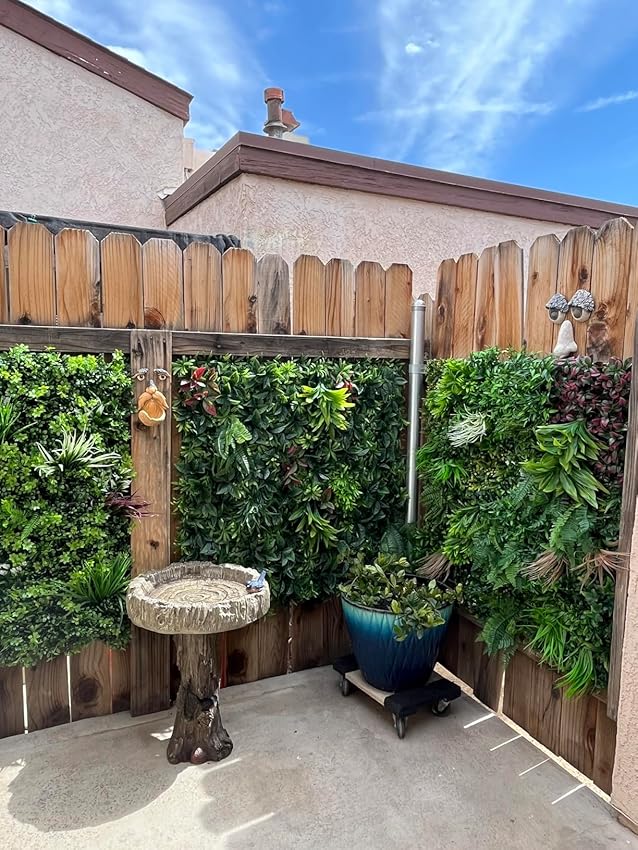Aquatic Plant Applications in 3D Artificial Vertical Gardens: Designing Moisture-Themed Green Walls for Indoor and Outdoor Spaces
Artificial vertical gardens offer a creative way to incorporate water-inspired aesthetics into spaces where real aquatic plants might struggle, such as dry interiors, shaded patios, or areas with limited access to natural light. By selecting designs inspired by water-loving species, these gardens can evoke the tranquility of ponds, streams, or wetlands without the need for constant moisture or maintenance. Below are strategies for integrating artificial aquatic plants into 3D vertical gardens for a dynamic, water-themed display.

Even without actual water, artificial plants can replicate the textures, shapes, and colors of species adapted to aquatic environments. This ensures a cohesive, nature-inspired look that feels at home in moisture-themed settings.
Floating and Emergent Plant Designs: Use artificial versions of water lilies, duckweed, or water hyacinth to mimic the way real plants drift on pond surfaces. These designs work well as focal points or scattered accents in vertical arrangements.
Grass-Like and Reed-Inspired Foliage: Incorporate artificial plants with long, slender leaves, such as those resembling cattails, bulrushes, or water iris, to add vertical height and movement. Their flowing forms evoke the gentle sway of real wetland plants.
Submerged Plant Textures: Introduce artificial plants with fine, feathery leaves, like those inspired by elodea, hornwort, or water milfoil, to create a sense of depth. These designs work best when clustered together to mimic the dense growth of underwater vegetation.
Aquatic ecosystems thrive on layered growth, with plants occupying different zones from the water’s surface to the pond floor. Artificial gardens can replicate this strategy for a dynamic, three-dimensional effect.
Surface, Mid-Water, and Bottom Zones: Place shorter, floating plants like artificial water lilies at the top of the arrangement to represent the water’s surface. Use medium-height grasses or reeds in the middle, and fine, submerged-style plants at the bottom. This creates an illusion of underwater depth, even in dry vertical spaces.
Overlapping Leaves and Stems: Allow some artificial plants to “drape” over the edges of panels or overlap with neighboring species. This mimics the way real aquatic plants intertwine and adds a sense of natural abundance.
Vertical Spacing for Airflow and Visual Clarity: Leave small gaps between plant clusters to prevent the garden from appearing overly dense. In artificial designs, these gaps also reduce dust accumulation and make the arrangement easier to clean.
Aquatic plants often feature soft greens, blues, and whites that reflect the colors of water and sky. Artificial designs can draw from these hues to create a calming, cohesive aesthetic.
Muted Greens and Blue-Greens: Stick to shades like sage, mint, or teal to evoke the look of algae-covered stones or submerged foliage. These colors work well as backdrops for more vibrant plants.
White and Cream Accents for Highlights: Incorporate artificial flowers or leaves in shades of white or pale yellow, like those inspired by water lilies or arrowhead plants, to mimic the way sunlight reflects off real aquatic blooms. Use these sparingly to create focal points.
Transparent or Translucent Elements: Introduce artificial plants with semi-clear leaves or stems, such as those resembling certain submerged grasses, to add a delicate, ethereal quality. These designs catch the light in a way that mimics real water distortion.
Aquatic environments feature a mix of smooth, flowing textures and rough, structural elements. Artificial gardens can replicate this diversity to add visual interest without the need for seasonal changes.
Smooth, Waxy Leaves: Combine artificial plants with glossy surfaces, like those mimicking water lilies or lotus leaves, with those featuring rougher textures, such as artificial cattail stems or reed fronds. This contrast adds depth and realism.
Fine, Thread-Like Foliage: Use artificial plants with delicate, hair-like leaves, like those inspired by water moss or filamentous algae, to add a sense of intricacy. These details work well as fillers between larger plants.
Sturdy, Upright Structures: Introduce artificial plants with thick, ribbed stems, like those resembling cattails or papyrus, to add architectural interest. These elements break up softer textures and evoke the resilience of real wetland plants.
By focusing on aquatic-inspired plant designs, layered arrangements, water-themed color palettes, and textural contrast, artificial plants can transform 3D vertical gardens into serene, moisture-evoking installations. Their durability and low-maintenance nature make them ideal for spaces where real water features are impractical, ensuring year-round beauty without the need for filtration, pruning, or constant moisture.
Contact: Amy
Phone: 86-15311787313
E-mail: info@foszmac.com
Whatsapp:86-15311787313
Add: Fengtai District, Dacheng Road, No.24 Building, Room 203, Beijing, China